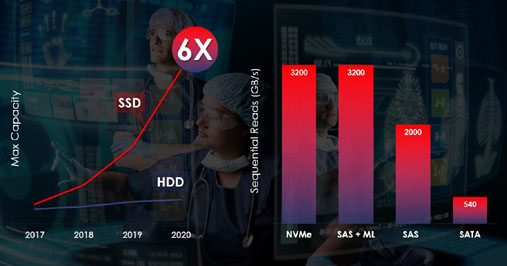Medical research enhanced by high performance computing (HPC) can really make a huge difference in our lives. One area is in mental health. Millions of people currently suffer from mental illness and it is projected that by 2030, mental health disorders will cost $6 trillion1. We have an opportunity to reduce both the suffering and huge cost implications caused by mental health disorders.
One way to improve mental health is by understanding how the brain works. Researchers are using an array of methods from cross-sectional brain scans to real-time analysis of neural activity which can generate Petabytes (PBs) of data. In working with consortiums that are building medical HPC clusters, their roadmaps today indicate they are needing hundreds and hundreds of PBs and that will be moving to Exabytes (EBs) in just a couple of years. And of course to access all this data, more bandwidth is required and will need to go from GB/s to TB/s.
So how will flash help? We just announced our largest capacity SSD to date and we are also seeing a path to a 128TB SSD by the end of the decade. That will be 6X the capacity of the highest capacity HDD, which will enable much denser solutions, so HPC clusters can now move primary storage into much denser and cost-effective footprints. And of course they need to access that data faster, so the SSD products we recently released, will have much higher performance. We all know that NVMe will provide much higher performance, but we also introduced MultiLink SAS™2, which is 4 SAS lanes with NVMe-like performance that can go into an existing, mature SAS infrastructure. The HPC community can take advantage of these innovations to keep up with the demands of their research and potentially help millions of people suffering from mental illness.

Sources: Internal Toshiba Research, July 2017; Internal Toshiba Research, May 2017
And this is just the tip of the iceberg. Many other aspects of our lives will be enabled by flash including IoT (Internet of Things), edge computing, smart cities, augmented reality, real-time analytics, infotainment/mobility of content and so on. Flash is just one piece of the puzzle, but the future as we know it wouldn’t be possible without it.
If you missed parts one and two, check them out here and here.
1World Economic Forum & Harvard School of Public Health Report, 2011
2MultiLink SAS is a trademark of the SCSI Trade Association
Disclaimer
The views and opinions expressed in this blog are those of the author(s) and do not necessarily reflect those of KIOXIA America, Inc.